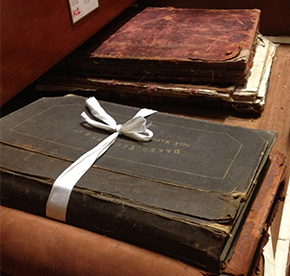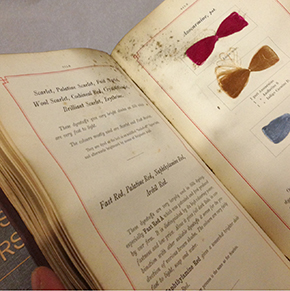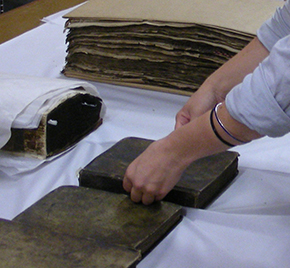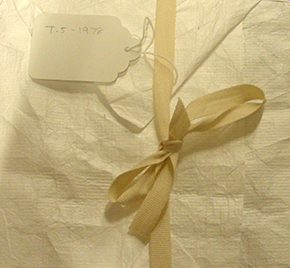Conservation Journal
Autumn 2013 Issue 61
Textile Sample Books Move
Jane Rutherston
Senior Books Conservator

Figures 1a and 1b. Sample books in old FTF storage, Photography by Anne Bancroft and Jane Rutherston © Victoria & Albert Museum, London
In June of this year, Book Conservation (BKC) were approached to assess and advise on the packing of a collection of around 200 textile sample books that needed to be moved in preparation for the opening of ‘The Clothworkers’ Centre for the Study and Conservation of Textiles and Fashion’.m The creation of the Centre is a project that will ‘bring the V&A's extensive textiles and fashion collection together under one roof, providing appropriate storage to enhance the long-term care of the collection’.1 The sample books covered a variety of sizes and structures ranging from ledgers to concertina and case bindings, using a variety of materials including leather, vellum, cloth and paper.
The deadline for the move was the end of August 2012, necessitating an urgent action plan in order to complete the work in the given time. Following an informal sample survey of the collection, it became apparent that approximately a third of the material was in a poor condition: some books displayed unacceptable deposits of surface dirt and/or mould and were probably acquired in this condition (Figure 1). A meeting was held when a quick assessment was made and a plan of action formulated:
- A basic survey would be written and information recorded on an Excel spreadsheet while preparing the books for their move
- All sample books with condition rating 3 or 4 would be boxed or put in a four flap folder (3= POOR: Poor condition, and/or restricted use, and/or probably unstable. Action desirable. 4= UNACCEPTABLE: Completely unacceptable condition, and/or weakened, and/or highly unstable, and/or affecting other objects. Immediate action should be taken). Due to time restrictions and lack of resources some of these would be measured and retrospectively boxed once funds for box board had been secured.
- Books with ‘red rot’ (the chemical deterioration of leather fibres resulting in a fine powder) would be given a full archive Manilla wrapper
- Books with no existing binding, or binding inadequate to protect the book block, would be placed between sheets of archive box board before wrapping
- All books would be wrapped in Tyvek® (a non-woven, high-density polyethylene material manufactured by Dupont™) and tied with linen tape, with the bow positioned on an edge
- Wrapped books would be packed in drawers with tissue wadding to minimise movement
- Student volunteers would be found to work on the project, providing them with project experience whilst supporting our limited resources
- Work would take place one day a week (a Thursday) from the beginning of July to the end of August
- Where possible some basic conservation/refurbishment would be undertaken
- Costings for archive box board would be provided

Figures 2a, 2b and 2c. Removing old mould spores and surface dirt using vacuum tweezers In extraction hood, Photography by Anne Bancroft and Jane Rutherston © Victoria & Albert Museum, London
It was agreed that within the confines of the time period, it would only be possible to deal with books affected by mould, red rot and/or heavy deposits of surface dirt, particularly as the collection is regularly accessed for research purposes by FTF staff, internal and external curators, subject specialists and the public. Mould-contaminated books needed to be isolated and treated as they posed a health and safety risk. Volumes with heavy deposits of dirt required surface cleaning to minimise the potential transfer of dirt to clean leaves and other objects as a result of handling by researchers (Figure 2). Volumes with red rot required a full wrapper to enclose the leather in order to minimise exposure to fine degraded particles of leather which some people are sensitive to and which may cause an allergic reaction.
A target of 25 books per day was met in order to move the collection in time. After training from Book Conservation, the volunteers, including Camberwell MA Book Conservation students and a Creative Industry Intern, worked alongside the Furniture Textiles and Fashion (FTF) Curator and Collections Management Assistant. Each week, the FTF staff ensured that books were laid out and ready to be prepared before the volunteers arrived (Figure 3). The volunteers worked in teams either in the store in-putting survey data onto the Excel spreadsheet, measuring for boxes and packing the books or up in the BKC studio, reducing dust and mould and, where possible, fitting the books into their boxes before returning them to the store for packing. FTF staff audited the collection in advance of packing, ensuring location update procedures were adhered to and packing the prepared books into the bespoke transport system the following day. Book conservators monitored the teams intermittently throughout the day, but towards the end of the project this became less necessary. The volunteers successfully met their target and the collection was safely moved to the new improved storage at Blythe House within the given time frame.

Figure 3. Working in the FTF store, Photography by Anne Bancroft and Jane Rutherston © Victoria & Albert Museum, London

Figures 4a and 4b. Sample wrapped in Tyvek and new storage showing phase boxed books, Photography by Anne Bancroft and Jane Rutherston © Victoria & Albert Museum, London
In addition to the above, a further 300-odd textile sample books were assessed by BKC as they also required surveying and packing for the move, although these were not required until late March 2013. It was agreed that they would be treated as part of phase 2 of the project and that FTF would provide £400 from their budget towards the cost of materials for phase boxing. The extended time period would allow BKC to ensure that all the volumes requiring basic refurbishment/conservation, surface cleaning, phase boxing or other forms of enclosure (condition rating 3 & 4) could be treated before packing. Camberwell student volunteers in the second year of their MA were approached to identify those who were able to work on the project over the next few months. It was proposed that during this period they would:
- Update the phase 1 survey to record volumes that had been boxed/treated
- Continue surveying the phase 2 volumes as before
- Measure books requiring boxing/four flap folders
- Undertake necessary conservation including surface cleaning and making up of the phase boxes
Phase 2 commenced on the 8th October 2012 and, at the time of writing, was running to schedule. The project emphasises the benefits of the V&A collaborating with student volunteers, the former receiving training and experience working in the museum environment, enabling the latter to actively deal with large projects and core collection work (Figure 4).
Acknowledgements
I would like to thank Tahiya Qureshi (Creative Industry intern) Philippa East (volunteer), Carla Busquets, Jenny Enos, Rebecca Goldie, Katherine Le, Emma Nichols and Jenny Snowdon (Camberwell MA Book Conservation student volunteers), Anne Bancroft (Senior Book and Paper Conservator), Suzanne Smith (Curator, Furniture Textiles and Fashion) and William Newton (Collections Management Assistant).
References
V&A Website https://www.vam.ac.uk/content/articles/f/futureplan-clothworkers-centre- FuturePlan: the Clothworkers' Centre for Textiles and Fashion Study and Conservation last accessed on 16th January 2013.
Autumn 2013 Issue 61
- Editorial
- The V&A’s Historic Stained Glass Windows
- An Investigation into the History of a Damascened Iron Games Table
- Collaboration with the Hirayama Studio, British Museum
- An ‘Exploded’ Replica of a Commode
- Smoke and Mirrors: What's holding Hollywood Costume up?
- Developing a Strategy for Dealing with Plastics in the Collections of the V&A
- Computer Love
- The Plaster Cast Courts Project: an introduction
- Historic Repairs
- Textile Sample Books Move
- Research on Paintings – A New Display
- David Garrick’s Tea Service